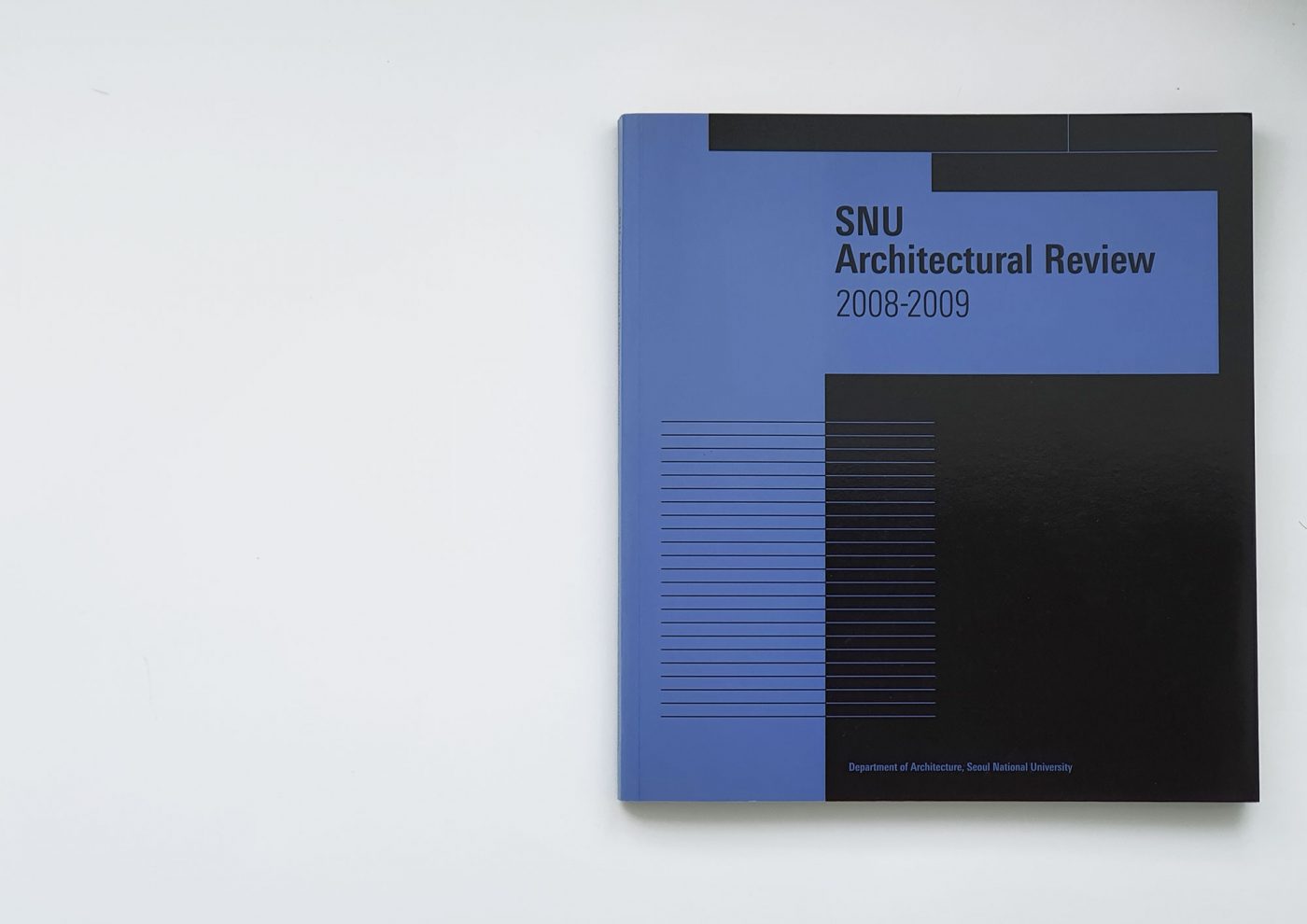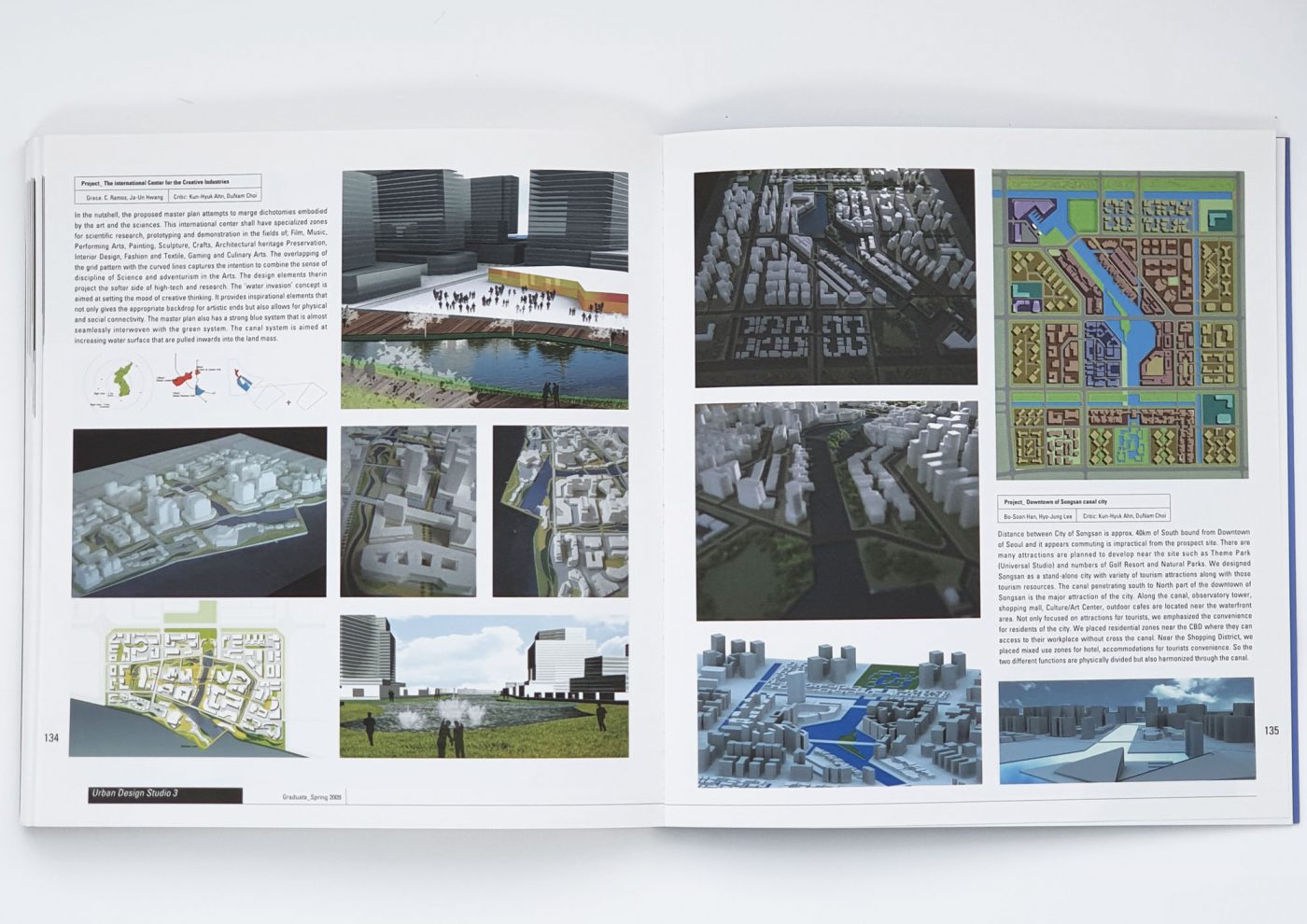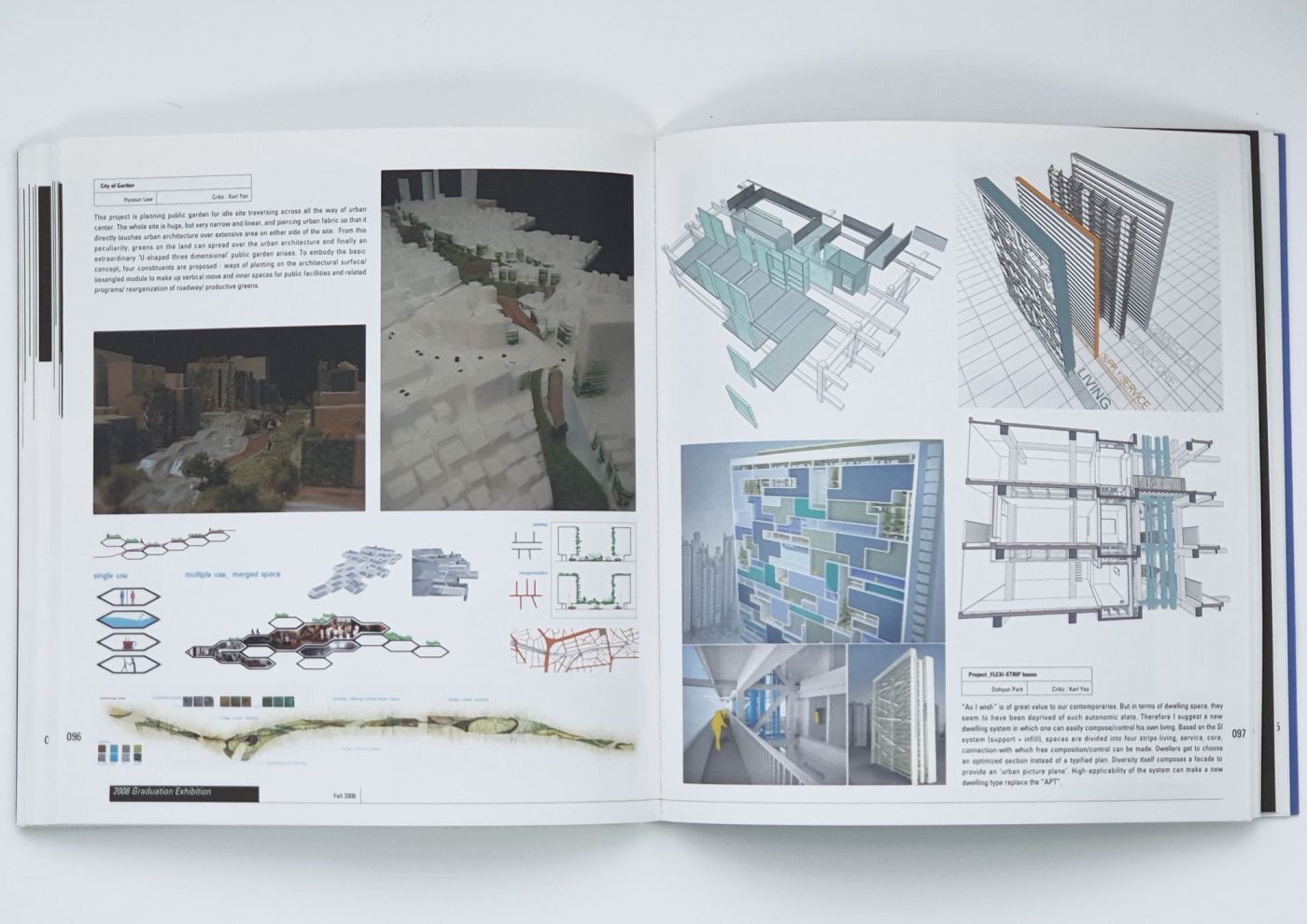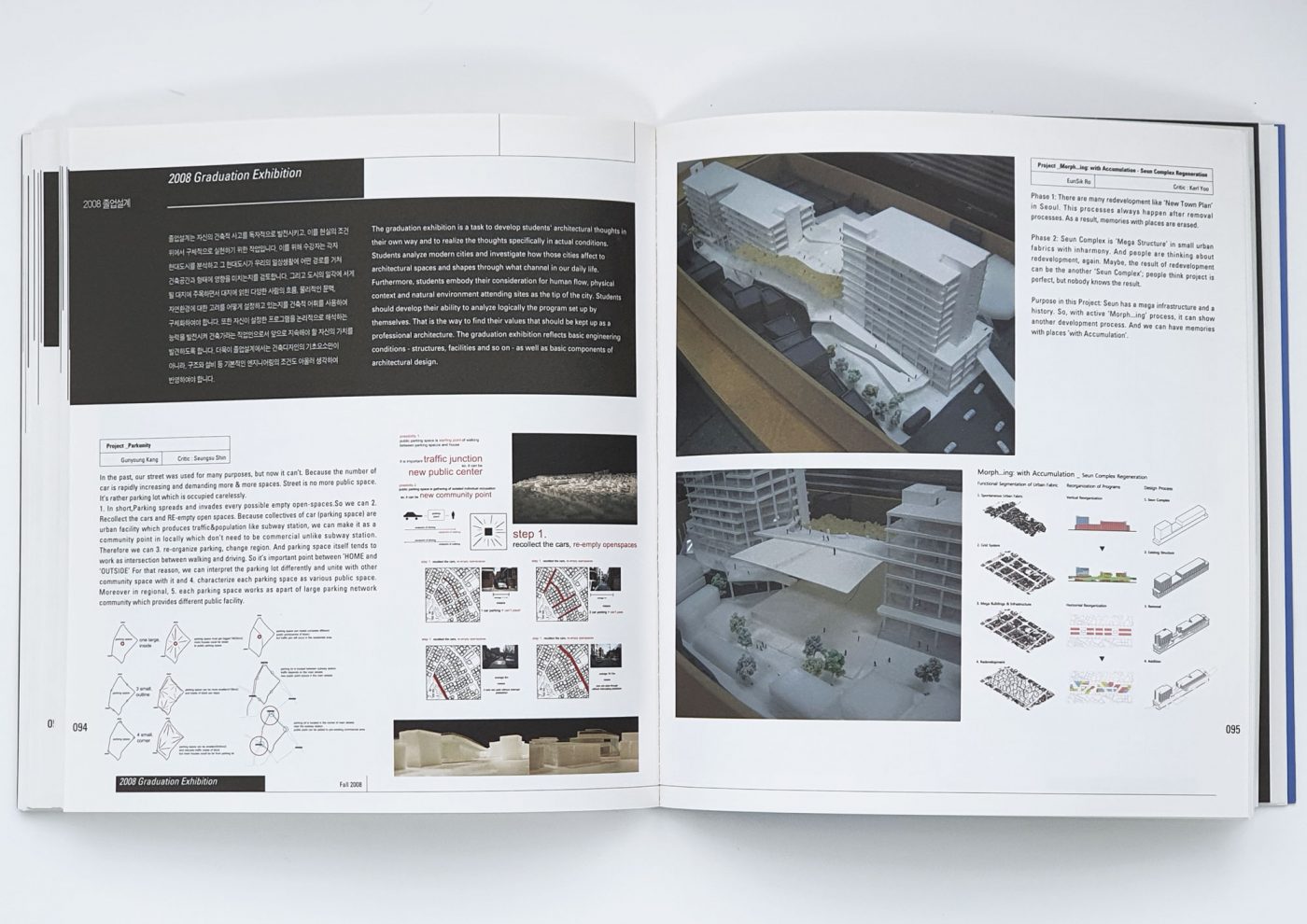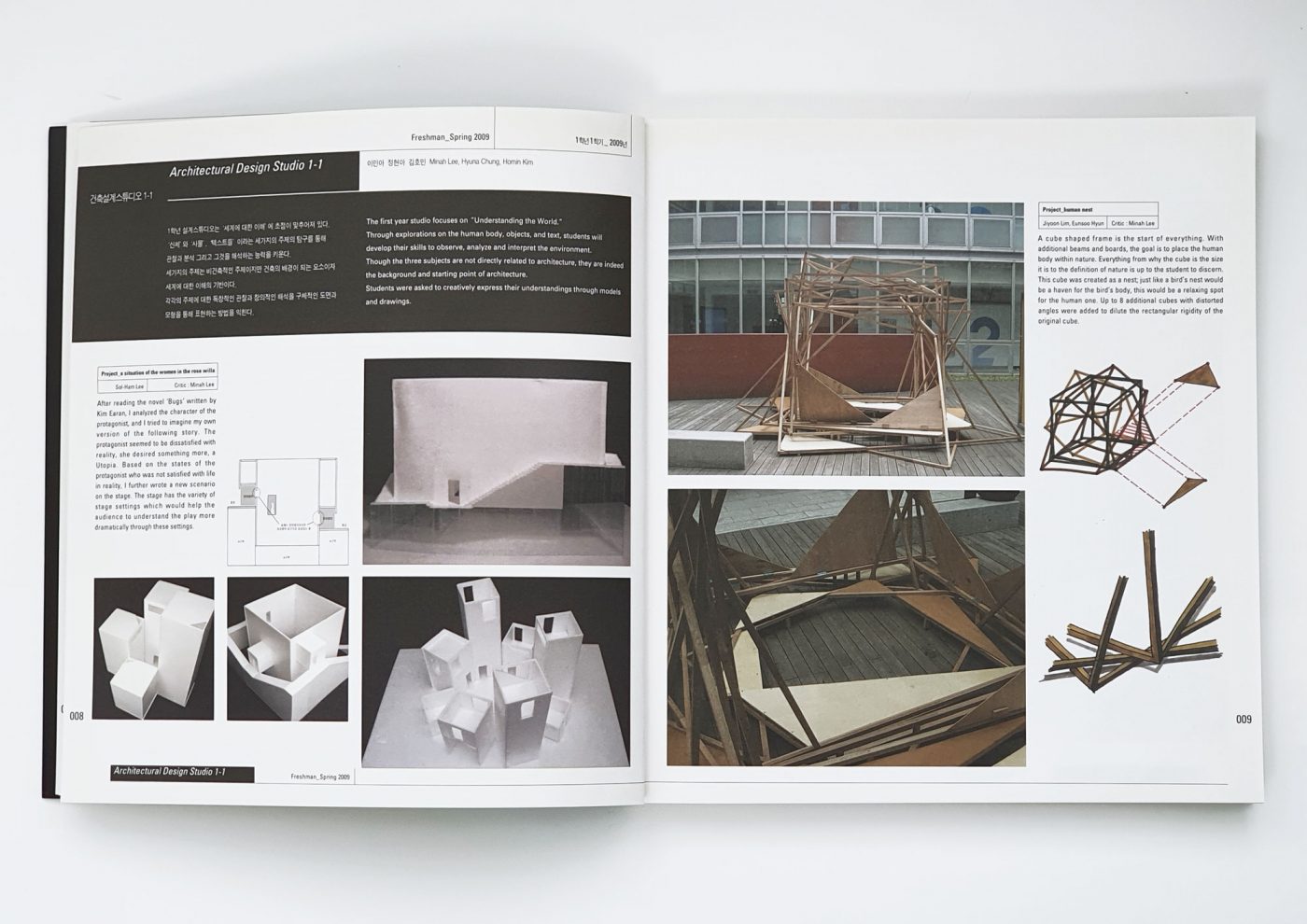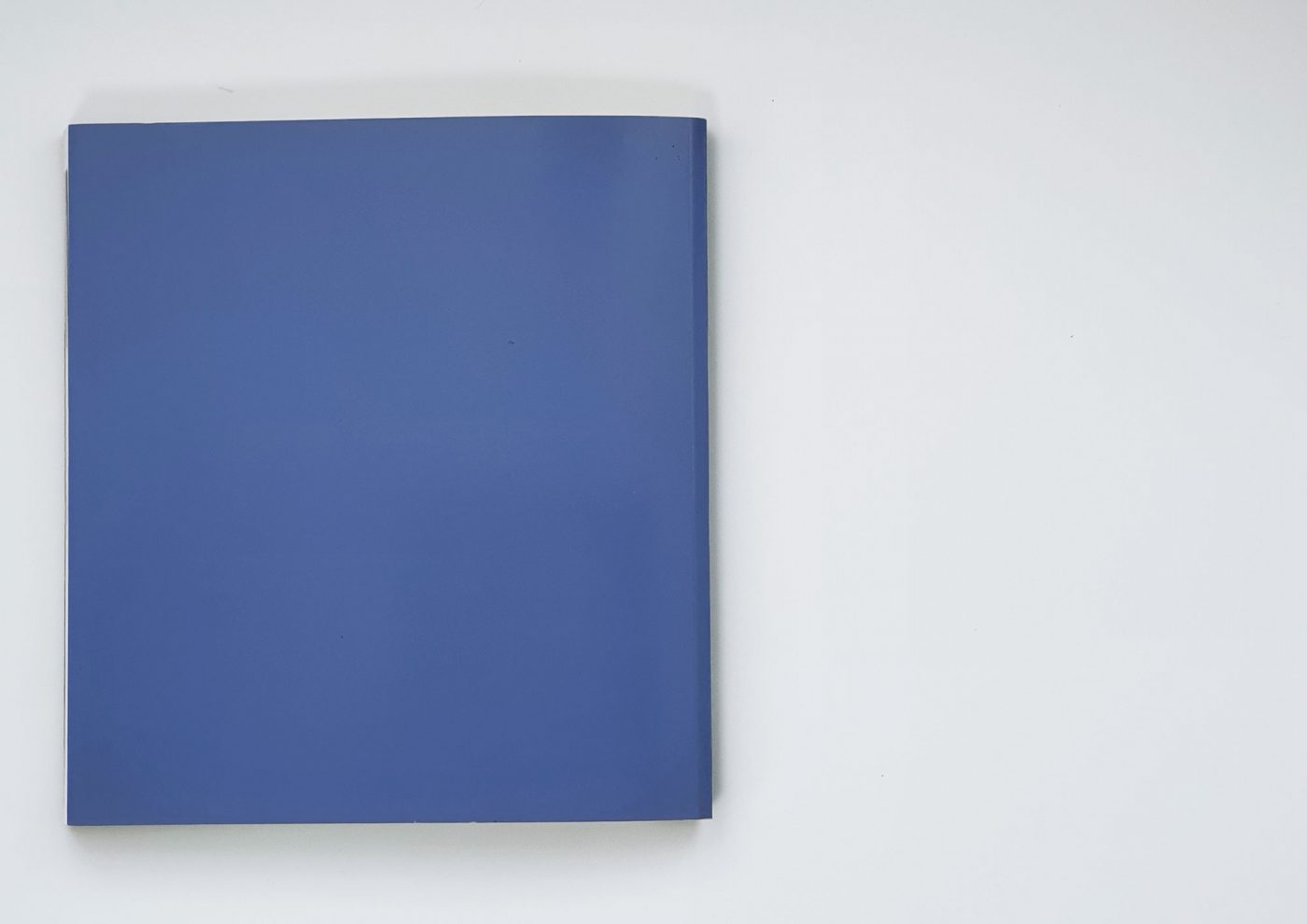SNU Architectural Review
2008 – 2009
2009, 1-1
건축설계스튜디오 1-1
신체, 사물, 텍스트
이민아, 정현아, 김호민
이솔함, 임지윤, 현은수, 구인영, 조예린, 송철호, 최동완, 문주희, Chanie Park, 이예슬, 박다솔, 김수현
1학년 설계스튜디오는 '세계에 대한 이해'에 초점이 맞추어져 있다. '신체' 와 '사물', '텍스트들' 이라는 세가지의 주제의 탐구를 통해 관찰과 분석 그리고 그것을 해석하는 능력을 키운다. 세가지의 주제는 비건축적인 주제이지만 건축의 배경이 되는 요소이자 세계에 대한 이해의 기반이다. 각각의 주제에 대한 독창적인 관찰과 창의적인 해석을 구체적인 도면과 모형을 통해 표현하는 방법을 익힌다.
The theme of this studio iws 'how to read the surronding and world'. Throught the researching on the 3 kinds of texts; things and place, we are developing abilitiies of observation, analysis and interpretation. Even though these 3 texts are not architectural themes, these are the background of architecture and the foundation of understanding the world. We are also learning how to express result of observation and unique analysis as a specific plan and model.
2008, 1-2
건축설계스튜디오 1-2
도시탐색 : 북촌, 홍대 앞, 강남
김진균, 김승회, 조정구
박은정, 서유정, 이세진, 김환기-1, 김환기-2, 박영준, 홍다솔, 이형빈, Kay-Hyun Lee-1, Kay-Hyun Lee-2
첫 스튜디오에서는 사물과 신체 그리고 텍스트에 대한 독해를 통해 세계를 이해하고 그것을 건축적 언어로 소통하고 상상하는 실험을 했다면, 두번째 스튜디오에서는 우리 삶의 배경이 되는 도시를 탐색하고 그 속에서 장소를 만들어내는 작업을 하게 된다. '세계에 대한 이해'라는 주제는 계속되지만, 우리 삶의 구체적인 일상에 보다 더 가깝게 접근하면서 우리 도시가 갖고 있는 다양한 시간과 공간을 체험하고자 한다. 3-6주를 단위(unit)로 해서 북촌, 홍대 앞, 강남 등 서울에 위치한 세 지역 안에 도시와 건축이 만나는 작은 장소를 제안한다. 또한 그와 더불어 각각의 지역에 대한 답사와 탐구의 기록을 담은 르포도 작성하게 될 것이다. 각 프로젝트 단위 사이에 있는 주말을 이용해서 답사를 하게 되며, 매 unit마다 공개 크리틱을 갖는다.
While the first studio experimented on expressing the student's creative understanding of the world, this studio explores cities and place-making within an urban context. The theme of "Understanding the World" continues, as students will be brought one step closer to the everyday world, experiencing the various times and spaces. Through three different units, with each unit lasting 3-6 weeks, students will propose places where architecture and cities come together on three different sites. They will also draft a reportage recording their site visits and design proecesses. Site visits will be taken on weekends between each unit, with each unit finishing with an open critique.
2009, 2-1
건축설계스튜디오 2-1
어떻게 구축할 것인가? 대지에서 공간구성까지
최두남, 피터최, 한지섭
홍다솔, 황민진, 박은정, Kay-Hyun Lee, 김강현, 권상진, 박영준, 신재희, 고승훈
이 과목은 공간을 설계함에 있어 주어진 환경 및 대지를 면밀히 관찰, 분석하고 공간구성의 틀을 만드는 기본적인 건축개념들의 학습을 통하여 사용자의 기능에 대한 요구를 만족시키며 개념이 내재된 조형을 이용하여 건출을 구축하는 방법을 습득하는 것을 목표로 한다. 건물을 포함한 전체 대지를 설계함으로써 대지분석에 대한 중요성을 강조하고 설계 진행과정에서 설계의도를 효율적으로 표현할 수 있는 설득력과 시각적 표현기법의 숙달을 꾀하며 자료 분석을 통한 사용자, 기능 및 프로그램에 대한 철저한 이해가 이루어질 수 있도록 한다.
The objective of this course is to help students to learn the process of design by encouraging them to get familiarized with the basic architectural concepts. Students are asked to carefully analyze the given context and the site, which are important part of design considerations, in the process of establishing architectural concepts that would reflect architect's aesthetic vision. Emphasis will be given on having students engaged in total design process in which students would learn to address such issues as site planning, program analysis and building design.
2008, 2-2
건축설계스튜디오 2-2
다중사용자 / 다중개체
심우갑, 김우일, 서을호
정인철, 박재현, 정민선, 변희영, 박우린, 신정인, 박민희, 최종빈, 유균형
이 과목은 설계를 진행함에 있어 공간 창출과 완성에 필요한 기술적인 측면에 대한 비중 있는 탐구를 통하여 재료에 대한 이해와 물성에 대한 감각을 높이며 건물이 구축되어지는 시공과정과 건물 구조 시스템에 대한 포괄적인 이해와 탐구가 이루어지도록 한다. 적절한 재료선택에 필요한 기본적인 건축적, 기술적인 지식을 바탕으로 다양한 구조시스템의 가능성 및 잠재성에 대한 개괄적인 이해가 이루어질 수 있도록 한다.
The objective of this course is to emphasize the importance of the technical aspect of architectural design by having students pay attention to building materials and structural systems. Students will have opportunities not only to examine the potential design possibilities of various structural systems but also to develop tectonic awareness of building materials.
2009, 3-1
건축설계스튜디오 3-1
다중 사용자/ 다중개체 설계
심우갑, 안우성, 김미희
정윤해, 정인춘, 박세준, 유균형, 진민주, 박재현, 김슬기, 최종빈, 변희영, 김지우
3학년 설계스튜디오는 단순 사용자 건물 혹은 단일개체 설계에서 다중 사용자/ 다중개체 설계를 나아감을 목표로 한다. 이를 위하여는 구조는 단일 완결 구조에서 반복구조로, 중규모의 다양한 사용자가 이용하는 기능을 다룬다. 이 과정에서는 다양한 건물관 관계 짓기/건물군과 도시 컨텍스트 사이 관계짓기로 이루어지는 배치계획과 특정한 형태를 고안하는 형태계획이 중점적으로 다루어진다. 기능상으로는 특수한 건축물이 갖추어야 할 프로그램에 대해 숙지할 기회를 제공한다. 이를 위하여 3개의 스튜디오에서는 서로 다른 3개의 프로그램을 상이한 대지조건에 설계하도록 하여 학생들에게 다양한 프로그램을 선택할 수 있는 기회를 제공한다.
Architectural design studio 3-1 has the goal of processing from a simple building for individual user to a complex building for various users. In the assignment, site planning and shape planning will be the main work derived from making relationship among different buildings, building complex and the urban context. Students will have the opportunity for understanding program of specialized buildings. For this, students can select their own program from 3 different projects in 2 groups.
2008, 3-2
건축설계스튜디오 3-2
건축가의 작품구성의도, 작업전략, 공간 및 형태구성 방식
장용순, 임재용, 김현철
김예리, 신세철, 이규빈, 이용준, 최수훈, 한유진, 강민지, 백수연, 이주현
건축설계의 기반을 이루는 총체적 건축계획에 대한 전문적 연구를 목표로 한다. 이론계획학의 한계에 머물지 않고 건축가들이 설계할 때 실제로 부딪쳐 온 작품구성의도, 작업전략, 공간 및 형태구성 방식을 광범위하게 분석함으로써 건축작품에 대한 이해를 넓힘과 동시에 그 결과를 자기 건축에 도입함으로써 독창적인 건축언어를 수립할 수 있는 기초와 근거를 연구한다.
This course aims to study professionally on comprehensive planning of architecture which forms the foundation of architectural planning, to broaden the width of understanding of architectural works through analyzing the ways of forming space and its shape beyond the limit of theoretical planning, and at the same time studies the groundwork to set up students' own creative language of architecture by introducing the studied results into students' works.
2009, 4-1
건축설계스튜디오 4-1
How to relate the squares to buildings
김진균, 윤정현, 장용순
문승규, 배근호, 김진화, 박대준, 이주현, 옥희지, 신세철, 정유리, 강민지, 신현재
Architectural Design Studio 4 aims to expand the student's perspectives to public spaces in an urban context, such as streets, squares and cities. First, students will build a groundwork for understanding the quality, scale and density of the city using various mapping tools into an urban collage. From these understandings of streets, students will then design a pedestrian-oriented square, the site and program of which will be chosen individually. For the individual buildings, their design qualities and level of details will be less critical for our main concern is how they relate the squares. Designs should be focused on facilities that can revitalize the square and transitional spaces(ie lobbies) between the square and buildings. rom this project students will not only understand the relationshop between public squares and architecture but also the relationship between pedestrians and urban components such as landscape architecture, engineering works, and infrastructure.
2008, 4-2
건축설계스튜디오 4-2
도시-건축
김광현, 함인선, 김태만
기세호, 임지형, 장유진, 조성현, 문주호, 이보름, 유진희, 정은석, 허전수
건축설계는 점차 도시의 영역으로 확대되어 감에 따라고 도시의 영역을 구축하는 작업으로 변화하고 있다. 도시 안의 건축설계는 도시설계를 구체화하는 일이며, 실제의 사업 목표와 매우 밀접한 관계를 가지고 있다. 도시를 구성하는 대단지를 구성하는 데 참여하는 발주자의 요구와 시행의 현실적인 가능성, 새로이 조성되는 주거지에 상업적 활기를 불어넣기 위한 대규모 건축 프로젝트를 연습함으로써, 공공발주와 그에 따른 각종의 사업적 요구사항을 충족하기를 요구하는 오늘날의 개발사업을 이해하고, 건축가가 이러한 프로젝트에서 어떤 창의력과 설득력으로 도시공간을 새롭게 창조하는 건축물을 만들어낼 수 있는가를 탐구하도록 한다.
With increased interest to accommodate various urban issues, Architectural design is changing its role to embrace a certain role of urban design, An architectural design in a city environment not only results a physical realization of an urban design but also accomplishes reaching a goal for the urban scale project. By looking at the urban design process from the earliest stage, students will examine requests of clients and feasibility of projects in order to seek creative ways to vitalize newly developing residential districts. In the process, they will understand the public procurement and its related businesses. The new role of architect is designing convincing architecture that creates unique urban spaces.
2009, 1-1
건축표현기법
공간구성의 기본개념
최두남, 전봉희
윤선경, Chanie Park, 조지현, 김상, 박세은, 현은수, 임지윤, 이예슬, 강재혁, 심수진, 조예린
이 과목은 지적 및 시각적 탐구를 통하여 공간구성에 대한 기본개념을 이해하고, 이를 다양한 건축기법을 통하여 표현할 수 있는 능력을 함양하는 것을 목적으로 한다.
The objective of this course is to encourage students to understand the basic principles of spatial organization through series of visual and intellectual excercises and to expose students to various architectural graphic skills to facilitate effective communication of design intentions.
2009, 3-1
건축재료계획
재료와 물성
김승회
최원아, 박찬호, 이승환
건축가에게 있어서 재료는 건축의 요소로 이해되는 것이 아니라 건축 그 자체이다. 그러므로 재료는 설계의 마지막 단계에서 결정되는 것이 아니라 첫 단계에서부터 대지와 프로그램과 함께 총체적으로 다루어져야 한다. 재료계획의 수업을 통해서 재료의 성질과 그 사용 방식에 대해 이해한다. 그 이해를 바탕으로 재료와 관련된 건축디테일을 탐구하고 실제 건축공간과 재료의 관계를 살퍼본다. 한편으로 재료의 본질과 개념에 대한 숙고를 바탕으로 새로운 물질성에 대한 탐구가 이루어진다. 목재와 유리, 금속등 구체적은 재료로 오브제를 만드는 과정을 통해 재료와 물질에 대한 속성과 물성에 대한 독창적인 해석과 창의적인 표현을 실험한다. 이러한 재료에 대한 이해를 바탕으로 그것이 실제로 어떻게 건축물을 통해 구현되는지 구체적인 사례를 통해 탐색하고 재료에 관한 총체적인 이해와 전망을 습득한다.
For the architect, the material is not considered as the element of architecture; the material is architecture itself. So, the material has not to be decided at the last process, but handled at the beginning with site and program. Through this course, it would be studied that character of material and its usage, architectural detail that material needs, researching of new materiality. Understand the nature of material and usage of it. To aware of it, explore architectural details related to the material. Consider the relationship between architectural space in real scale and the materials. At the same time, research on physical make-up as new stood on the consideration about an essence and concepts of material. By making an object with specific materials like wood, glass, metal etc. experiment unique interpretation and creative presentation. Search the case how architecture is embodied, by understanding material, and learn the prospect and general understanding.
2009, 3-1
공학설계 1
드로잉
이병연, 임상진
김은진, 백장운, 최윤정
건축공학을 전공함에 있어서 기본이 되는 드로잉과 기초적인 설계를 통하여 도면작성요령과 도면을 이해하는 방법을 익힌다. 도면은 건축물로 표현하는 방법이며 설계. 구조, 시공분야에 종사하는 사람들의 의사소통의 매개체로서 매우 중요하다. 도면을 읽고 머릿속에 3차원의 그림을 그릴 수 있는 능력이 필요하다. 이를 위하여서는 먼저 측정과 스케일에 대한 개념을 가지고 간단한 도면을 작성하며 설계를 통하여 이를 체득하게 한다.
Through drawings and basic design based on the architectural engineering, we learn how to draw and comprehend the blueprint (plan). The blueprint (plan) is very important since it is a way to express a building and a medium among people working in many other positions ? design, structure, construction, and etc. We required the ability to read a blueprint (plan) and to come across one Øs mind the spatial view. To achieve this ability, we learn to design and draw the blueprint (plan), holding the concept of dimension or scale.
2008
졸업설계
졸업설계
강건영, 노은식, 류효은, 박도현, 박민환, 박상연, 윤희영, 이소연, 임리사, 임지환, 장수정, 장지을, 조준희, 배익환, Rosa Kim, 김은성, 최원석, 김수영, 권병기, 배한얼, 박진규, 이기출, Daekyueng Kim, 김원종, 김도형, 김광민, 서동훈, 최주영, 하태욱, 이선영, 박연주, 김경민, Hea sung Kang, 권혜영, 최문정
졸업설계는 자신의 건축적 사고를 독자적으로 발전시키고, 이를 현실의 조건 위에서 구체적으로 실현하기 위한 작업입니다. 이를 위해 수강지는 각자 현대도시를 분석하고그 현대도시가 우리의 일상생활에 어떤 경로를 거쳐 건축공간과 형태에 영향을 미치는지를 검토합니다. 그리고 도시의 일각에 서게 될 대지에 주목하면서 대지에 얽힌 다양한 사람의 흐름, 물리적인 문맥, 자연환경에 대한 고려를 어떻게 설정하고 있는지를 건축적 어휘를 사용하여 구체화하여야 합니다. 또한 자신이 설정한 프로그램을 논리적으로 해석하는 능력을 발전시켜 건축가라는 직업인으로서 앞으로 지속해야 할 자신의 가치를 발견하도록 합니다. 더욱이 졸업설계에서는 건축디자인의 기초요소만이 아니라, 구조와 설비 등 기본적인 엔지니어링의 조건도 아울러 생각하여 반영하여야 합니다.
The graduatioon exhibition is a task to develop students' architectural thoughts in their own way and to realize the thoughts specifically in actual conditions. Students analyze modern cities and investigate how those cities affect to architectural spaces and shapes through what channel in our daily life. Furthermore, students embody their consideration for human flow, physical context and natural environment attending sites as the tip of the city. Students should develop their ability to analyze logically the program set up by themselves. That is the way to find their values that should be kept up as a professional architecture. The graduation exhibition reflects basic engineering conditions - structures, facilities and so on - as well as basic components of architectural design.
2009, 대학원 1학기
건축설계연구 1
주택
김현철
신윤정, 우견재
건축설계의 기본이라 할 주택 작품을 완성하는데 주안점을 두고 독립적으로 독창적인 설계프로젝트를 운영할 수 있도록 연습한다.
Focusing on the completion of housing design which is considered as basis of architectural design, this course aims at practicing how to run an architectural design project independently and creatively.
2008, 대학원 2학기
건축설계연구 2
도시주거 및 전시/상업시설
박승홍
김홍재, 방석환, 황성주
project description / project 도시주거 및 전시/상업시설 설계(urban dwelling and exhibition/commercial facility design) / 경복궁 동측 사간동 및 소격동 일대(현대 갤러리와 국제 갤러리 사이) / Segan-dong(Eastern part of Kyungbokgung) and Sokyuk-dong(In between Hyundai gallery and Kukje gallery) / 사이버시대가 도래한 시점에서 새로운 삶의 형태를 주도할 수 있는 주거의 방법을 제안하도록 한다. 주거에서 추구되어온 전통적인 가치의 변화를 반영할 수 있는 새로운 패러다임을 모색하는 과정을 통하여 역사성과 공공성의 의미를 재조명하도록 한다. 또한, 현대사회는 문화의 시대라 할 만큼 한 나라의 문화가 사회전반에 미치는 영향이 각별한 상황이다. 특히 글로벌 시대에 즈음하여 독특함이 두드러지는 문화의 창출 및 이를홍보, 보존, 전시하여 관련 전문문야는 물론 시대를 반영하는 역동적인 문화를 일반대중들에게 제대로 전달시킬 수 있는 새로운 전시체계와 물리적 여건을 조상하는 것이 절실하게 필요한 사항이다. 전시시설 설계에 있어 기존의 전시시설을 분석하고 이를 토대로 향후 추구되어야 할 전시시설 설계의 체계적, 물리적 패러다임을 건축설계를 통하여 모색하도록 한다. 현대 전시 공간체계의 특징으로 나타나는 자유로운 구성을 주조로 한 전시공간, 건축표현 수단으로서의 전시공간, 공간위계질서에 따른 전시공간 등을 분석하고 전시공간의 새로운 패러다임을 제안하도록 한다.
2009, 대학원 1학기
건축설계연구 3
High-rise Building in urban fabric
최두남
김영우, 변진식, Kwengsoo Lim
project: High-rise Building in urban fabric / site: 서소문 공원 주변 / goal: 도심 속의 high-rise building의 형태 상징성을 넘어서 도시 문화를 통합할 수 있는 총체적 건축이 될 수 있는 방안을 모색한다.
This course aims at exploring the way in which high-rise building in urban core can be the whole archiecture involving urban culture beyond its formal symbolizm.
2009, 대학원 1학기
도시설계스튜디오 1
urban core area
김광중, 김정훈
엄수진, 장수정, 양승호, 추민영, 이조원, 이현지, 곽서연, 정현범
This studio course puts special emphasis on the better understanding of the today's inner-city development. It provides basic analytical framework for understanding evolution of urban-core area, and skills to handle today's complicated urban situations. In this course, students should seek to improve their knowledge on urban planning, urban economics, social, cultural, and historical context of urban core area, and urban design techniques needed. With the knowledae basis, students can develope their own methodology of manipulating built-environment of urban core area - and that composes the core part of this design studio.
2009, 대학원 1학기
도시설계스튜디오 2
how to revitalize decaying inner-city area
김광중, 김정훈
백현아
In Urban Design Studio II, students can develope various design skills and their design process based on more fundamental design issues including meaning of urban community, sustainability and how to keep urban diversity in our built environment. Students will be grouped by team with 2 or 3 members, and each team will be assigned to a part of entire study area. Major objective of the design project is seeking out how to revitalize decaying inner-city area considering future vision and potential of Seoul, in a more creative ways, focusing fundamental issues.
2009, 대학원 1학기
도시설계스튜디오 3
a new town in the suburban area of Seoul
안건혁, 최두남
백현아, A-Jing Yu, Grace. C. Ramos, 황자운, 한보순, 이효정
As a final studio course, Urban Design Studio 3 provides students with intense experience of planning and design of a new town in the suburban area of Seoul. Again, students are grouped by teams, and each team will be given different study sites. Until mid-term presentation, each team will work on large-scale planning issues including the identity of the new town, relationship with existing towns around, major arterial systems and transit systems, etc. After the mid-term presentation, each team selects area of interest and develope detailed site planning of the area. Through the course, students will be able to learn the fundamental of physical planning of a city and synthesize their theoretical knowledge and design skill.
